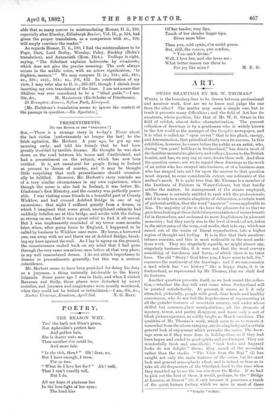ART.
SWISS DRAWINGS BY MR. W. THOMAS.*
WHERE is the boundary-line to be drawn between professional and amateur work, how are we to know and judge the one from the other The matter may seem a simple one, but in truth it presents many difficulties ; and the field of Art has its amateurs, whose position, like that of Mr. W. G. Grace in the field of cricket, almost defies characterisation. The present collection of drawings is by a gentleman who is widely known in the Art world as the manager of the graphic newspaper, and it is what is called an "open secret " that to his pluck, energy, and determination, that periodical chiefly owes its success. In this exhibition, however, he comes before the public as an artist, who, during "ten years' holidays in Switzerland," has drawn most of the familiar mountains, glaciers, and valleys, known to the British tourist, and has, we may say at once, drawn them well. And then the question comes, are we to regard these drawings as the work of an artist who has strayed into business, or of a business-man who has strayed into art ? for upon the answer to that question must depend, to some considerable extent, our estimates of the author's merit. It is quite true that Mr. Thomas is a member of the Institute of Painters in Water-Colours, but that hardly settles the matter. In management of the means employed, Mr. Thomas is certainly entitled to rank with the professionals, and it is only in a certain simplicity of delineation, a certain want of pictorial artifice, that the word "amateur" seems applicable to him. The majority of the w rks have the pleasure for us that we gain from looking at them faithfulrepresentations of scenes beauti- ful in themselves, and endeared to most Englishmen by pleasant memories ; but they rarely rise to the level of works of art, taken in the strict sense of the term,—of works, that is to say, which are raised out of the realm of literal reproduction, into a higher region of thought and feeling. It is in this that their amateur- ishness consists, and this is most noticeable in the most ambi- tious work. They are singularly equable, we might almost say, singularly business-like, if it were not that the word conveys something of harshness and hurry, of which there is no trace here. The old " Story ! God bless you, I have none to tell, Sir," expresses the sentiment of the drawings ; and if we can conceive a land which has "no history" like a happy State, it is in Switzerland, as represented by Mr. Thomas, that we shall find its features.
Another question presents itself, as we look round the collec- tion,—whether the day will ever come when Switzerland will be painted satisfactorily. At present, it seems as if it only attracted, pictorially, people with good, clear heads and healthy consciences, who do not feel the hopelessness of representing at all the grander features of mountain scenery, and under whose skilful but common-place manipulations, all the elements of mystery, terror, and poetry disappear, and leave only a sort of bleak picturesqueness, as coldly bright as March sunshine. The qualities of Mr. Thomas's work, which seem to us to remove it somewhat from the above category, are its simplicity and a certain general look of enjoyment which pervades the series. The draw- ings seem as if they were done in holiday-time, as if they had been begun and ended in good spirits and good temper. They are wonderfully fresh and unwstbetic, "lank locks and haggard looks do not delight" them ; they smack of the mountain rather than the studio. "The View from the Rigi " (2) has caught not only the main features of the scene, but its exact look and general atmospheric effect, and is indeed so true as to take all old frequenters of the Oberland, back to the time when they tumbled up to see the sun rise from the Kulm. If we had to pick out the best of these, it would, perhaps, be the "Bridge at Lucerne at Sunset" (6), if only because it possesses a touch of the quiet, human feeling, which we miss in most of these
• " Graphic " Gullerf.
works. It is a beautiful drawing, warm in tone and subdued in effect, showing the "Reuse "shining in the sunset, and the towers and walls of the city dark against the sky. The two studies of the Matterhorn, "Hope" and "Defeat" (16 and 23), are elaborate, careful drawings, aiming, perhaps, at a poetical quality which has not been successfully ob- tained; and the study of the old Swiss woman (45) is very faithful and finely executed. It is noticeable that all these works have a delicacy of colouring which makes them pleasant, and which is quite unallied to the old chromo-lithographic prettiness, that used to pervade all Swiss and Italian scenes as rendered by English artists. It is needless to describe the drawings in detail,—they are of curiously average merit, and such lakes as Than, Zug, Lucerne, and Geneva, such passes as the Bruneck and the St. Gothard, and such glaciers as those of Grindelwald and the Rhone, are familiar to all of us. The collection is a pleasant one to all who know Switzerland, and will show all those who do not, what the country is like, when seen without either dyspeptic fancies or rose-coloured spectacles-



































 Previous page
Previous page